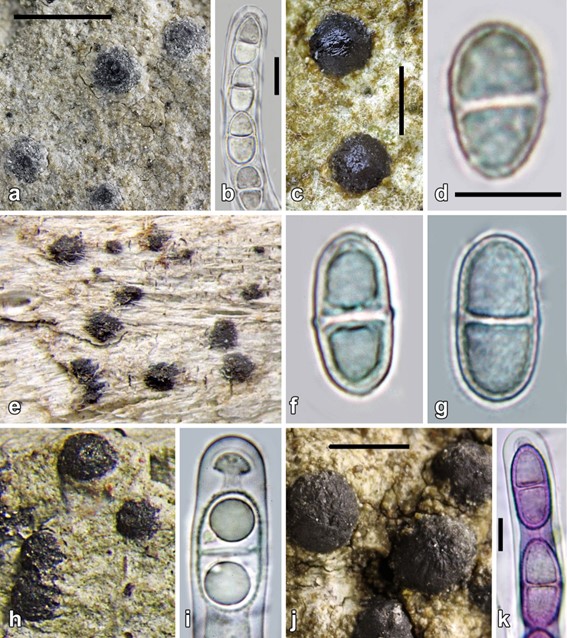Acrocordia A. Massal., Geneac. Lich. (Verona): 17 (1854).
MycoBank number: MB 46; Index Fungorum number: IF 46; Facesoffungi number: FoF 08071; ten morphologically defined species (Lücking et al. 2017), molecular data available for one species.
Lichenized on bark or rarely on bryophytes or on limestone, in temperate to tropical montane regions. Thallus ecorticate, white. Photobiont Trentepohlia. Ascomata scattered or rarely clustered, erumpent to sessile, black, carbonaceous, ostiolate, ostiole apical or lateral. Involucrellum present or reduced, carbonized. Excipulum dense, consisting of compressed hyphae, appearing prosoplecten- chymatous in thin, bleached sections, hyaline to brown or brown-black. Hamathecium comprising 0.5–0.7 µm wide paraphyses, hyaline, straight, branched and anastomosing. Asci (2–)8-spored, bitunicate, fissitunicate, cylindrical, short pedicellate, with broad, non-amyloid ocular chamber and fluorescent cap-structures. Ascospores mostly uni-seriate, rarely biseriate, ellipsoid-oval to rarely oblong, hyaline, 1-septate, usually granular ornamented. Pycnidia rare. Conidia acrogenous, microconidia, aseptate, oblong to ellipsoid to fusiform, small, hyaline. Chemistry: Secondary substances absent.
Type species: Acrocordia garovaglii A. Massal., Geneac Lich (Verona): 17 (1854) [= A. conoidea (Fr.) Körb. var. conoidea, Syst Lich Germ: 358 (1855)].
Notes: This genus was not treated in detail by Lücking et al. in Hyde et al. (2013). Acrocordia resembles both Anisomeridium and Monoblastia in general habit. It differs from the first in the broad ocular chamber of the asci and from the second in the 1-septate vs. aseptate ascospores (Fig. 50). The septum usually has characteristing endospore thickenings that make it appear laterally somewhat bulging (Fig. 50).
Arthopyrenia endobrya (≡ Anisomeridium endobryum; Megalotremis endobrya) is an unusual lichen that grows intracellularly within dead bryophytes, known from tropical montane forest in Brazil (type; Döbbeler and Poelt 1981) and Costa Rica (Aptroot et al. 2008). It is characterized by sessile, basally constricted, black perithecia and 1-septate ascospores 35–50 × 10–15 µm in size. Harris (1995) recognized its position within Monoblastiaceae and placed it in Anisomeridium. Because of its slight septal endospore thickenings, it was later recombined into Megalotremis (Aptroot et al. 2008), although the ascospore size range (see below Megalotremis for further discussion) fits Anisomeridium better, Given the ecorticate thallus, the fully exposed perithecia, the asci with broad ocular chamber, and the thin-walled ascospores lacking crystals and with the septa slightly bulging (Fig. 51), the species is actually best referred to Acrocordia, where several other species have sessile, subglobose perithecia, such as A. subglobosa. The biseriately arranged ascospores apparently lacking granular ornamentation deviate from most of the other species in that genus, but such variation is also accepted in Anisomeridium (see below). The necessary combination is introduced below.

Fig. 50 Morphology, asci and ascospores in Acrocordia species. a–d A. conoidea (a, b Germany, Schumm 70; c, d Germany, Schumm 12542). e–h A. gemmata (e–f Portugal, Schumm 11491; g Portugal, Schumm 11547; h, i Germany, Schumm 11586). j, k A. salweyi (Por- tugal, Aptroot & Schumm 14215). Scale bars: a, c, j = 1 mm, b, d, k = 10 µm. For further illustrations of species of this genus, see also Schumm (2008, 2011) and Schumm and Aptroot (2013)

Fig. 51 Morphology, asci and ascospores of Acrocordia endobrya (Costa Rica, Sipman 51790). a, b Thallus on dead bryophytes with perithecia and perithecia enlarged. c–e Mature and immature asci showing broad ocular chamber. f–h Ascospores. Scale bars: a, b = 1 mm, c, d = 50 µm; e, f, g = 10 µm
Species
Acrocordia garovaglii
